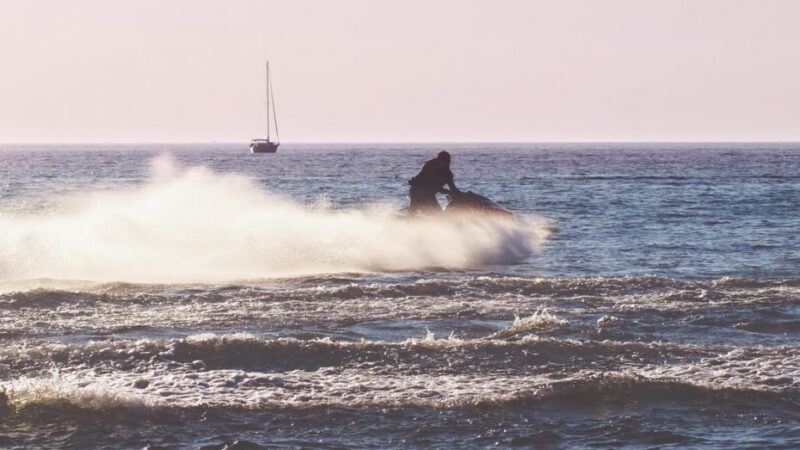The Board will consider updating which portions of the Willamette River will allow wakesurfing

During a work session about rules passed regarding the Newberg Pool in February, the Oregon State Marine Board presented newspaper clippings about the conflicts among users of the section of the Willamette River roughly between Newberg and West Linn. They were published as early as 2005.
Since that time, the board has tweaked the rules several times, including new ones that went into effect in February to address concerns regarding congestion and large wakes that damage docks and erode riverbanks as well as law-enforcement struggles.
Agreeing that the rules passed in February might need to be tweaked, the board opened the rulemaking process yet again during its meeting Thursday, Oct. 24, which was a day after the work session.
While previous rules placed a ban on wake-enhancement devices, which homeowners have said significantly exacerbate wake impact, rules that went into effect in February established specific portions of the river where wakesurfing, which causes the biggest wakes, can be performed and areas where it is outlawed.
They also established that wakeboarders need to stay 200 feet away from docks and wakesurfers need to be 300 feet from docks.
After hearing from homeowners about portions of the river where wakesurfing is allowed and seeing videos of wakes violently crashing into docks and myriad boaters congesting the river, the board decided to reexamine the zones and might add more areas where wakesurfing is not allowed.
However, the rulemaking process will not reexamine other rules like distance-from-dock requirements. An advisory committee will soon be convened and the rules likely will be prepared for the board to consider at either the January or April meeting.
“I think the general sentiment is to have an increase of red (no wakesurfing) zones,” said Josh Mulhollem, Marine Board policy manager. “Wakesurfing will (likely) be restricted in more areas than it is currently, but we’re going to start an advisory committee to determine what those zonal changes might look like.”
The board also directed staff to look at ways to simplify the rules, which a few people who testified during the work session said were confusing. Potential ways they could do this, Mulhollem said, is to reduce the number of zones and delineate them based on landmarks rather than buoys.
“It’s obvious to me that we don’t have a solution yet and this is going to have to evolve,” said Marine Board member Craig Withee. “It’s apparent that in some stretches of the river it’s too congested.”
Marine Board Chair Val Early suggested that it might be better for the board to adopt rulemaking that created more uniform regulations statewide rather than concentrating on the Newberg Pool. However, the board did not do that.
“If we go statewide, we don’t accomplish what we need to in the Newberg Pool,” Withee said.
Mixed results
The rules passed in February were largely created by Active Water Sports President Matt Radich and former Oregon River Safety Preservation Association President Steve Gregg. Radich represented the boating point of view and Gregg the homeowners’ view. The two tried to create rules that satisfied both sides. However, the rules ended up infuriating those whose homes resided in the portions of the river that allow wakesurfing.
During the meeting, three people whose homes reside in the wakesurfing zone in miles 41.4 to 42.4, described a hellacious summer resulting from the new rules and showed videos of wakesurfers sending large waves toward their docks.
“The rules don’t work. The zones increase congestion and safety issues. They are not enforced and the wakes are far worse than previous years,” Leslie Harris said.
And the board seemed sympathetic to their concerns, highlighting that section as an area that could be changed to a non-wakesurfing zone.
“That’s a tight area. As much as I like to keep the river open, that’s an area I think we can look at,” said board member Vince Castronovo. “Boats are too close. They’re not adhering to the rules.”
Radich acknowledged that the zones could be tweaked but advised the board not to impose drastic restrictions on wakesports.
“I want it to be a cooperative thing. How do we make sure that the families that love to do this have the opportunity and the businesses that rely on this are still there. I don’t want to not have a job because we can’t wakesurf,” he said.
Linda Peppler, a resident near Dog Ridge Road in Newberg, lauded the current rules, which banned wakesurfing in her portion of the river.
She said that while erosion, congestion and dock damage have been pervasive in the past 10 years or so, these potential negative results from wake activities did not take place to nearly the same degree in her section of the river this year.
In her view, there should be a designated place for wakeboarders and surfers to go, just not in front of her dock.
“I would hate for this section of the river to be ruined again,” she said.
A confusing summer
The current rules were inspired by a wake study conducted in the summer of 2018 that showed that a regular boat traveling 100 feet from a dock creates the same wake impact as a wakesurfer traveling 300 feet from a dock.
Those rules will remain unchanged along with the general idea of zones for wakesurfing, which some said were confusing and difficult to enforce.
Clackamas County Sheriff’s Office Sgt. Nate Thompson, for one, was not a proponent of the rules.
“There’s a lot of zones and the zones were very confusing for some, and they were very confusing and frustrating for law enforcement,” Thompson said. “I’m staring at a laptop and GPS and we’re still confused with what zone we’re in. If I’m confused, it seems difficult for me to issue citations to somebody else.”
Mullhollem said that law enforcement presence doubled from previous years while Thompson said that only 13% of documented contacts were for violations related to the zoning rules.
“There’s some significance to that because that’s what we were up there to enforce,” Thompson said.
Mulhollem said that based on board staff’s perceptions, wakesurfers as well as wakeboarders and tubers tended to remain in the zones where wakesurfing is allowed.
“Tubing and wakeboarding also stayed away from those (no wake) zones. I’m not sure if that’s because of misunderstanding of rules or other factors,” Mulhollem said.
Mulhollem also pointed out that the preponderance of unauthorized buoys might have led to confusion about the zones. Thompson was skeptical of the longevity of the rules due to the wear and tear of the buoys and especially the extra strain on law enforcement.
He advocated for the board to create distance rules that apply to all recreators instead of trying to organize them in sections. He also said the rules had deleterious effects on
the lower Willamette River such as the portion near Milwaukie.
“What a lot of this rule in this area has done has forced boaters to go other places, a lot of that within my county. We saw a large amount of congestion just outside of the zone,” he said.
Castronovo said the rules will be more effective once the boater safety education program for wakeboarders and wakesurfers, which the board approved during the meeting, goes into effect.
He would have preferred if other river users also were required to take an education course, but the legislation related to that program limited the scope to just wakeboarders and surfers.
“Obviously we’ve had a first season and things aren’t working as well as we had hoped, but we don’t have the education part in yet,” he said.
Quality local journalism takes time and money, which comes, in part, from paying readers. If you enjoy articles like this one, please consider supporting us.
(It costs just a few cents a day.)







Recent Comments